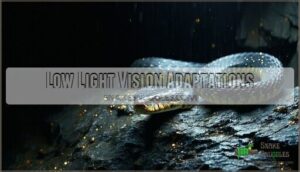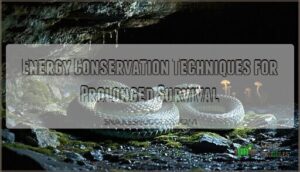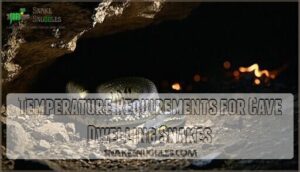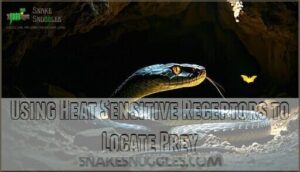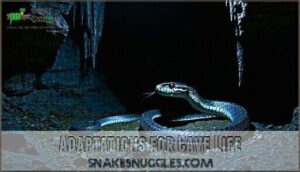This site is supported by our readers. We may earn a commission, at no cost to you, if you purchase through links.
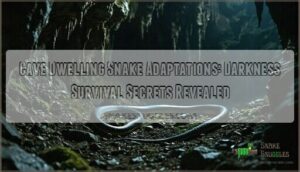 You’ll discover cave dwelling snake adaptations for darkness are truly remarkable evolutionary marvels.
You’ll discover cave dwelling snake adaptations for darkness are truly remarkable evolutionary marvels.
These serpents develop heat-sensitive receptors that work like thermal goggles, letting them "see" warm-blooded prey in complete blackness.
Their eyes often shrink or disappear entirely, while other senses become supercharged – think enhanced smell and vibration detection that’d make a bloodhound jealous.
Many species grow elongated, slender bodies perfect for squeezing through tight rocky crevices.
Their scales often become specialized for gripping cave walls, turning them into skilled rock climbers.
These adaptations reveal nature’s incredible problem-solving abilities when faced with extreme environments, showcasing nature’s adaptability.
Table Of Contents
- Key Takeaways
- Cave Dwelling Snake Adaptations
- Surviving in Dark Cave Environments
- Temperature Requirements for Cave Dwelling Snakes
- Hunting Strategies in Dark Caves
- Adaptations for Cave Life
- Cave Dwelling Snake Behavior and Social Structure
- Conservation and Captive Care for Cave Dwelling Snakes
- Frequently Asked Questions (FAQs)
- What animals live in caves have adapted biologically to darkness?
- Do cave dwelling rat snakes have eyes?
- What are four ways that animals have adapted to life in a cave?
- How do snakes survive in caves?
- What are the adaptations of the black rat snake?
- What temperature do cave dwelling rat snakes like?
- How do cave snakes navigate without visual cues?
- What are the unique breeding habits of cave-dwelling snakes?
- How do cave snakes defend against predators underground?
- Do cave snakes have special venom adaptations?
- Conclusion
Key Takeaways
- You’ll develop incredible heat-sensing abilities through specialized pit organs that detect temperature differences as small as 0.003°C, turning you into a living thermal camera that can hunt warm-blooded prey in complete darkness.
- Your eyes will shrink or disappear entirely while your other senses become supercharged – you’ll rely on enhanced smell through rapid tongue-flicking and vibration detection to navigate your underground world.
- You’ll evolve a slender, flexible body shape with specialized scales that provide superior grip on cave walls, allowing you to climb vertical surfaces and squeeze through tight rocky crevices with ease.
- You’ll master energy conservation by dramatically reducing your metabolic rate by up to 30% and entering torpor states, enabling you to survive months without food in resource-scarce cave environments.
Cave Dwelling Snake Adaptations
You’ll discover how cave-dwelling snakes have evolved remarkable heat-sensing superpowers that let them hunt warm-blooded prey in pitch-black darkness.
These underground specialists have also developed slender bodies and specialized gripping scales that help them navigate tight cave spaces with surprising ease, utilizing their superpowers to thrive in such environments.
These serpents navigate impossibly tight spaces with their streamlined bodies, turning cave walls into superhighways through specialized grip scales.
Heat Sensitive Receptors for Prey Detection
When darkness falls, you’ll discover cave snakes’ remarkable heat-sensitive pit organs act like thermal night-vision goggles.
These specialized receptors detect temperature differences as small as 0.001°C, creating detailed heat maps of warm-blooded prey moving through pitch-black caves.
- Pit organ sensitivity pinpoints mouse body heat from several feet away
- Infrared detection range extends beyond normal vision limits in darkness
- Prey heat signatures appear as glowing targets against cool cave walls
- Receptor evolution fine-tuned these organs over millions of years
- Thermal camouflage becomes useless against these precision heat detectors
Enhanced Sensory Organs for Navigation
When exploring pitch-black caves, you’ll find that cave snake adaptations create a sophisticated sensory network.
These darkness adaptations transform snakes into living radar systems through enhanced sensory organs:
- Pit organ sensitivity detects temperature differences as small as 0.001°C, creating thermal maps of prey
- Vomeronasal organ use processes chemical trails days after prey passes through areas
- Magnetoreceptor navigation helps detect Earth’s magnetic field for spatial orientation
Brain sensory processing coordinates these snake adaptations, while directional scent tracking further enhances hunting.
Brain sensory processing coordinates these snake adaptations, while lateral line detection in aquatic species adds vibration sensing capabilities.
Slender Body Shape for Cave Navigation
Cave-dwelling snakes squeeze through impossibly tight spaces thanks to their streamlined design.
You’ll find these serpents sport incredibly flexible skeletons and specialized muscle structures that let them contort like living rubber bands.
Their slender body shape acts like nature’s perfect cave navigation system, allowing seamless confined space movement through rocky mazes where bulkier predators can’t follow, utilizing their flexible skeletons.
Specialized Scales for Rock Climbing
Like tiny rock-climbing cleats, specialized scales give cave snakes incredible grip on limestone walls.
Each scale features microscopic ridges that create enhanced traction through adaptive evolution.
This climbing behavior lets them scale vertical surfaces and navigate tight crevices with ease.
Key adhesion mechanisms include:
- Scale microstructure with microscopic ridges for superior grip
- Specialized toe pads that increase surface contact area
- Flexible scale edges that conform to irregular rock surfaces
- Enhanced keratin density providing durability for repeated climbing
Surviving in Dark Cave Environments
You’ll find that cave snakes have developed remarkable vision tricks to survive in total darkness.
These reptiles rely on heat-sensitive pit organs and enhanced chemical detection to navigate and hunt when their eyes can’t help them anymore.
Low Light Vision Adaptations
Some cave snakes have evolved remarkable low light vision that’d make night photographers jealous.
Their pupils dilate dramatically to capture every photon, while specialized rod cells boost light sensitivity.
Though many species develop reduced eyes beneath translucent scales, they still maintain rudimentary vision for detecting movement and shapes in near-total darkness.
| Adaptation | Function |
|---|---|
| Pupil Dilation | Opens wide like camera aperture for maximum light intake |
| Enhanced Rod Cells | Specialized retinal cells detect minimal light sources |
| Translucent Scales | Allow light penetration to underlying eye structures |
| Reduced Eyes | Energy-efficient organs optimized for cave environment |
| Opsin Proteins | Active light-detecting molecules maintain vision capability |
Relying on Smell and Hearing for Hunting
Hunt becomes precise when you rely on chemosensory hunting and auditory prey detection instead of sight.
Cave snakes use enhanced olfactory navigation to track chemical trails days after prey passes through.
Vibrational sensing lets them detect:
- Airborne scent particles through rapid tongue flicking and enlarged vomeronasal organs
- Substrate vibrations from moving crickets, bats, and small mammals nearby
- Sound waves bouncing off cave walls for precise prey detection timing
Silent movement completes their stealthy approach.
Energy Conservation Techniques for Prolonged Survival
When food becomes scarce, cave snakes dramatically slash their metabolic rate by up to 30%.
This reduced metabolism triggers torpor mechanisms that help them survive months without eating.
Their bodies maximize oxygen efficiency while relying on stored fat reserves.
Slow digestion extracts every nutrient from prey, making energy conservation their ultimate survival strategy in challenging cave environments.
Some snakes even use specialized scales for insulation to conserve energy.
Unique Physiological Adaptations for Low Oxygen Levels
Cave snakes’ respiratory adaptations help them survive in low-oxygen environments through enhanced blood hemoglobin levels and improved oxygen metabolism.
Their slower heart rate and efficient respiratory system maximize energy conservation while stored resources support extended survival periods.
These metabolic adaptations let them thrive where other species can’t handle the challenging cave atmosphere.
Temperature Requirements for Cave Dwelling Snakes
You’ll need to maintain precise temperatures between 75-88°F to keep your cave snake healthy, since these reptiles rely on external heat sources for survival.
Most species drop their body temperature slightly at night, mimicking the natural cool-down they’d experience in their rocky underground homes.
Optimal Temperature Range for Thermoregulation
Your cave snake thrives in ideal temperatures between 64-79°F (18-26°C).
This stable range supports proper thermoregulation without wasting energy on constant movement.
Captive heating should maintain consistent warmth, mimicking natural cave environment conditions.
Heat conservation becomes easier when temperatures stay within this narrow band, allowing your snake’s thermal sensing abilities to function perfectly for hunting and digestion.
Behavioral Adaptations for Regulating Body Temperature
When temperature requirements are met, cave snakes employ clever behavioral adaptations for thermoregulation.
These serpents master microhabitat selection and activity adjustment to maintain ideal body temperature in their cave environment.
Snakes, being ectothermic, rely on external heat sources, so temperature control matters for survival.
- Basking behavior in warm air pockets near geothermal vents
- Crevice snuggling between rock surfaces for heat retention
- Curling strategy to minimize surface area and conserve warmth
- Activity adjustment reducing movement during cooler periods
Supplemental Heat Sources for Captive Snakes
Keeping your cave-dwelling snake comfortable requires proper heating equipment and thermostat regulation.
Under-tank heaters create stable temperature gradient control, while ceramic emitters provide consistent warmth without light.
Many pet owners purchase reptile heating supplies for this purpose.
| Heat Source | Temperature Range |
|---|---|
| Under-tank heaters | 24°C-26°C steady |
| Ceramic emitters | 21°C-28°C gradient |
| Heat lamp safety | Daytime use only |
| Infrared panels | Even distribution |
| Thermostat systems | Precise control |
The table outlines various heat sources and their characteristics, including temperature range and usage guidelines, to help owners make informed decisions about reptile heating supplies.
Hunting Strategies in Dark Caves
You’ll discover that cave snakes have turned darkness into their greatest hunting advantage using specialized heat-sensitive pit organs that detect prey like living heat maps.
These serpentine cave dwellers employ clever ambush tactics, scaling walls with grip-enhanced scales to snatch unsuspecting bats right out of the air.
Using Heat Sensitive Receptors to Locate Prey
While cave temperatures stay fairly stable, these serpents rely on something far more sophisticated for hunting success.
You’ll find their heat-sensitive pit organs work like biological thermal cameras, detecting infrared radiation from warm-blooded prey with incredible precision.
These remarkable sensors create detailed thermal maps of their surroundings, making even the smallest bat impossible to miss.
These organs rely on TRPA1 ion channels to convert thermal energy into electrical signals.
- Pit organ sensitivity detects temperature differences as small as 0.003°C
- Infrared prey detection works perfectly in complete darkness conditions
- Heat map accuracy guides precise strikes toward moving targets
- Thermal sensitivity compensates for reduced vision in cave environments
Ambush Predation Techniques for Capturing Bats
You’ll witness nature’s perfect predator as cave snakes employ silent approach techniques and vertical ambush strategies.
Their strike precision reaches 56% accuracy in total darkness, relying on bat detection through heat sensors and vibrations for flawless timing.
These masters of ambush predation position themselves on cave walls, using specialized scale grip to hang from ceilings.
Adaptations for Scaling Cave Walls and Catching Prey
In spite of their underground lifestyle, cave-dwelling snakes master vertical ambush hunting through remarkable adaptations.
You’ll discover these climbing structures that make them deadly predators:
- Specialized ventral scales provide superior scale grip on damp limestone surfaces
- Prehensile tails anchor snakes during midair bat capture strikes
- Slender body shapes navigate tight crevices where prey hides
- Enhanced chemoreception reliance guides precise positioning for silent approach
- Flexible muscle structure enables coiling on vertical cave walls
These snake adaptations transform ordinary hunters into gravity-defying predators.
Adaptations for Cave Life
You’ll discover how cave snakes have transformed their bodies to survive in perpetual darkness through remarkable physical changes.
These reptiles have evolved reduced eyes, enhanced non-visual senses, and specialized skin features that help them thrive where most animals can’t even survive, showcasing their ability to adapt with remarkable physical changes.
Reduced Eye Size and Rudimentary Eyes
Over millions of years, cave snake eyes have shrunk dramatically through eye regression.
This evolutionary tradeoff prioritizes energy conservation over vision in pitch-black caves.
Reduced eye size prevents injury reduction from rocky surfaces while eliminating costly visual processing.
Cave dwelling snake adaptations redirect resources from useless eye degeneration toward survival-critical senses.
Light sensitivity becomes irrelevant when darkness reigns supreme.
Enhanced Sensory Organs for Compensating Vision Loss
When you lose your sight, you’d better ramp up your other senses.
Cave-dwelling snakes develop incredible enhanced sensory organs to navigate complete darkness.
Their vomeronasal organ function processes chemical signals with remarkable precision, while specialized pit organ sensitivity detects minute temperature changes.
These cave dwelling snake adaptations transform reduced vision into heightened sensory adaptations for survival.
Unique Skin and Scale Adaptations for Cave Life
Cave-dwelling snakes showcase remarkable skin and scale adaptations that’ll leave you impressed.
Their specialized scales develop microscopic ridges for superior grip on slick cave walls, while reduced pigmentation creates natural skin camouflage in darkness.
- Scale texture becomes smoother for effortless cave navigation through tight spaces
- Sensory pits embedded in scales detect vibrations and chemical traces
- Moisture-retaining adaptations prevent dehydration in humid cave environments
- Specialized scales resist abrasion from constant contact with rough limestone surfaces
Cave Dwelling Snake Behavior and Social Structure
You’ll find that cave-dwelling snakes display unique social behaviors shaped by their harsh underground environment.
These serpents have developed specialized communication methods and territorial patterns that help them survive in perpetual darkness.
Solitary Behavior and Territoriality
Beyond their physical adaptations, you’ll find cave snakes are true loners with serious territorial marking habits.
These solitary hunting experts use scent trails for territorial defense, avoiding neighbors through chemical communication.
Each snake claims specific cave mapping territories, creating invisible boundaries that prevent conflicts.
This snake isolation strategy maximizes limited cave resources while reducing dangerous encounters in darkness.
Mating and Breeding Habits in Captivity
Unlike their territorial nature, cave dwelling snake adaptations shine during captive breeding programs. You’ll witness fascinating courtship rituals as males follow pheromone trails through careful tongue-flicking behavior.
Here’s what successful captive breeding involves:
- Seasonal humidity manipulation mimics natural breeding cycles
- Males increase activity during mate selection periods
- Small clutches require precise egg incubation temperatures
- Delayed fertilization helps optimize timing for harsh cave conditions, which is crucial for the successful breeding of these unique species, and understanding their natural breeding cycles.
Social Interactions and Communication Methods
You’ll find cave snakes rely heavily on chemical signals for communication in total darkness.
Pheromone signaling and scent marking help males track receptive females through chemical cues.
Territorial marking establishes boundaries, while head bobbing provides tactile feedback.
These sensory adaptations replace visual communication, making mate selection possible without sight in underground environments.
Conservation and Captive Care for Cave Dwelling Snakes
You’ll face unique challenges when keeping cave dwelling snakes in captivity since these specialized reptiles need precise conditions that mirror their natural underground world.
Successfully caring for these remarkable creatures requires understanding their specific habitat needs, feeding patterns, and handling requirements to guarantee they thrive outside their natural cave environment.
Habitat Replication and Environmental Enrichment
Several factors make successful habitat replication essential for cave dwelling snake adaptations.
You’ll need precise environmental controls that mirror their natural underground world. Rock formation structures provide climbing opportunities while substrate depth allows natural burrowing behaviors.
Effective cave lighting systems with red bulbs to maintain darkness while enabling observation are vital, and understanding advanced cave lighting systems can enhance conservation efforts.
- Cave lighting systems with red bulbs to maintain darkness while enabling observation
- Humidity control units maintaining 80-90% moisture levels for proper respiratory function
- Water quality monitoring ensuring clean, mineral-rich water sources mimic natural cave springs
Dietary Requirements and Feeding Strategies
Cave-dwelling snakes need specialized prey selection for ideal health.
Rodents are the go-to grub, served weekly and warmed to activate their heat sensors – like microwaving dinner for your snake.
Their slow digestion rates mean they’ll extract maximum nutrients from each meal.
These ambush predators have adapted feeding habits that require patient food storage between meals, sometimes surviving months between feedings in their cave dwelling environment.
Handling and Maintenance Techniques for Captive Snakes
Proper snake handling requires steady hands and snake hooks for safe captive care.
These cave dwelling snake adaptations mean they’re sensitive to movement and temperature changes.
Support their body fully, maintain consistent humidity control in their enclosure design, and handle minimally.
Your snake feeding schedule affects their temperament—recently fed snakes become more docile.
Understanding snake behavior helps prevent stress during handling techniques and routine maintenance.
Effective snake care also involves using proper snake handling tools to minimize risk and guarantee safety.
Frequently Asked Questions (FAQs)
What animals live in caves have adapted biologically to darkness?
While you’d expect darkness to blindfold cave animals, they’ve actually developed superhuman-like abilities.
Cave fish lose their eyes but gain pressure sensors.
Blind salamanders use chemical detectors.
Beetles develop ultra-long antennae for navigation.
Do cave dwelling rat snakes have eyes?
Most cave-dwelling rat snakes retain reduced eyes beneath translucent scales, though they’re substantially smaller than surface relatives’.
You’ll find these eyes provide basic light detection but aren’t functional for vision in perpetual darkness.
What are four ways that animals have adapted to life in a cave?
Like treasure hunters adapting to dark mines, you’ll find cave animals develop enhanced senses, lose pigmentation, conserve energy through slower metabolism, and evolve specialized body shapes for traversing tight spaces.
How do snakes survive in caves?
Snakes use heat-sensitive pit organs to detect warm prey, enhanced smell and hearing to navigate, reduced energy needs through slower metabolism, and specialized scales for gripping cave walls effectively.
What are the adaptations of the black rat snake?
In terms of adaptation, black rat snakes aren’t sitting ducks – they’re remarkably versatile.
You’ll find they’ve developed excellent climbing abilities with specialized belly scales, strong muscles, and flexible spines that help them scale trees and rocky surfaces with ease, which makes them excellent climbers.
What temperature do cave dwelling rat snakes like?
You’ll want to keep your cave-dwelling rat snake comfortable at 75-88°F during the day, dropping slightly at night. They’re pretty adaptable and will find warm spots naturally.
How do cave snakes navigate without visual cues?
You’ll be amazed how cave snakes navigate like living GPS systems.
They use heat-sensitive pit organs to detect tiny temperature differences, enhanced smell through tongue-flicking, and vibration sensors to create mental maps of their dark underground world, allowing them to effectively navigate through their environment like a living system.
What are the unique breeding habits of cave-dwelling snakes?
You’ll find cave-dwelling snakes use energy-saving breeding strategies.
They mate less frequently, produce fewer eggs, and time reproduction with rare food availability.
Some species can delay egg development for months until conditions improve, using rare food availability to their advantage.
How do cave snakes defend against predators underground?
You’ll rely on stealth, camouflage, and reduced aggression instead of active defense.
Your translucent skin blends with cave walls while slower movements conserve energy and avoid detection by the few underground predators.
Do cave snakes have special venom adaptations?
Cave snakes don’t typically develop specialized venom adaptations for underground life.
You’ll find most cave-dwelling snakes rely on constriction or are non-venomous species that adapted to cave environments through enhanced sensory abilities rather than modified toxins.
Conclusion
Research shows that cave-dwelling snakes can detect temperature differences as small as 0.003°C, making them incredibly efficient hunters.
You’ve learned how cave dwelling snake adaptations for darkness transform these reptiles into specialized survivors. Their heat-sensing abilities work like biological night vision goggles.
Enhanced smell and vibration detection replace diminished eyesight perfectly. Slender bodies and grip-ready scales turn rocky walls into highways.
These remarkable evolutionary solutions prove that nature always finds creative ways to thrive in Earth’s most challenging environments, using biological night vision goggles and heat-sensing abilities to make them incredibly efficient hunters.

